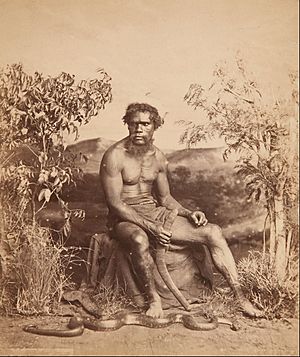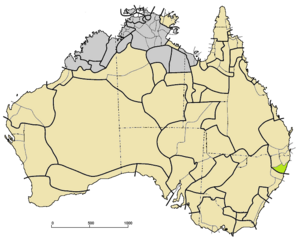Gumbaynggirr facts for kids
The Gumbaynggirr people are an Aboriginal Australian group. They live on the Mid North Coast of New South Wales. Their traditional lands stretch from the Clarence River to Stuarts Point. They also reach inland to Guyra and Oban. A group called Gumbathagang was likely a clan or sub-group of the Gumbaynggirr.
Contents
History
The first European to meet the Gumbaynggirr people was Clement Hodgkinson. He explored the Nambucca and Bellinger River areas in March 1841. About 30 years later, in the 1870s, loggers began cutting down cedar trees. They worked their way up the Orara River.
Around 1873-1874, a photographer named J.W. Lindt took pictures of local Aboriginal people. He photographed them in their natural environment and during traditional ceremonies. He also took portraits in his studio. People at the time said his photos were the first to show Aboriginal people "truthfully as well as artistically."
A newspaper, the Sydney Morning Herald, wrote about the photos in 1874. It said the northern rivers area was great for studying Aboriginal life. It noted that the local people still kept their customs. This was more so than tribes in other parts of New South Wales. The article praised Mr. Lindt for his artistic work.
The loggers clearing the land made it possible for new settlers to move in. These settlers started living on tribal lands in the early 1880s. Soon after, a shepherd was killed in the area. A group of hunters was sent to get revenge. This led to the terrible Red Rock Massacre.
The killings began at Blackadder Creek, where the Gumbaynggirr were camping. Mounted police entered the camp and started shooting. Those who ran away were chased to Corindi Creek, where more were shot. Survivors were driven to a headland and forced off the rocks into the sea. The hunters kept shooting at those in the water. However, some people hid in a cave and later reached Corindi Lake. One survivor was the grandmother of today's elder, Tony Perkins. She hid in thick reeds with a child in her arms.
After a court case that lasted 20 years, the Gumbaynggirr won a land claim in 2014. The New South Wales Land and Environment Court confirmed their right to much of the reserve land.
Many Aboriginal reserves and missions were set up in NSW. This was done by the Aboriginal Protection Board. Aboriginal people were often moved from their traditional homes. This caused great sadness and harm, especially for the Stolen Generations. These were children taken from their families.
The Gumbaynggirr have the largest shell deposit, called a midden, in the Southern Hemisphere.
Country
The Gumbaynggirr lands cover about 5,957 square kilometers (2,300 square miles). This area is on the Mid North Coast. It stretches from the Nambucca River north to the Clarence River near Grafton. It also goes east to the Pacific coast.
Norman Tindale said their land was bordered by the lower Nymboida River. He noted it reached towards Urunga, Coffs Harbour, and Bellingen. It included South Grafton and Glenreagh. The coastal area south from One Tree Point, Woolgoolga, and Nambucca Heads was also part of their country. The thin coastal strip from Coffs Harbour to Evans Head belonged to the Yaygir people.
To the north of the Gumbaynggirr were 20 groups speaking different Bandjalung dialects. The Jukambal were to their west. The Nganyaywana/Anēwan lived near Armidale. Their southern borders met the lands of the Djangadi and Ngamba peoples.
Language
Gumbaynggir is one of two Gumbaynggiric languages. These languages belong to the larger Pama–Nyungan family. In 1986, the Muurrbay Aboriginal Language and Culture Co-operative was started. Gumbaynggirr elders created it to bring their language back to life. Language classes began in 1997. By 2010, hundreds of people had learned some of the language.
Culture
The word Muurrbay in Gumbaynggir means "the white fig tree". This tree is very important in the Gumbaynggir Yuludarla. These are the Gumbaynggirr Dreamings or traditional stories.
The Gumbaynggirr people also made sweets, which they called jaaning. These were like "bush lollies." They made them by rolling soft shoots from the Acacia irrorata tree in its sticky sap.
Some words
- Giinagay (hello).
- Yaam darruy ngiina gaduyaygu (It's good to meet you).
- Yaarri yarraang. (goodbye).
Alternative names
- Coombagoree, Gumbanggar
- Coombangree, Coombyngura, Coombyngara, Coombargaree, Kombinegherry
- Gumbainggar, Gunbainggar, Gumbaingar, Guinbainggiri
- Gumbangeri
- Kombaingheri, Kombinegherry, Kumbangerai, Koombanggary, Koombanggherry, Koombainga
Possible clans or sub-tribes
- Gumbathagang, led by "King Robert" (also known as "King Bobby" or "King Malawangi") in the late 1800s.
- Nimboy (a group or 'horde').
- Orara (named after a river).
- Woolgoolga (a group or 'horde').
Notable people
- Frank Archibald, a respected elder. The Frank Archibald Memorial Lecture Series is named after him.
- Aretha Brown, a youth activist.
- Troy Cassar-Daley, a country music singer-songwriter from Halfway Creek/Grafton NSW.
- Emma Donovan, a singer and songwriter with Gumbaynggirr heritage from her mother's side.
- Gary Foley, an activist, academic, writer, and actor.
- Albert Kelly, a rugby league player.
- Tasman Keith, a hip hop artist.
- Loretta Kelly, a law academic.
- Aden Ridgeway, a former Australian Senator.



